Challenges and Opportunities for App Development Startups in 2023
Ashok Sachdev
July 24, 2023 901 Views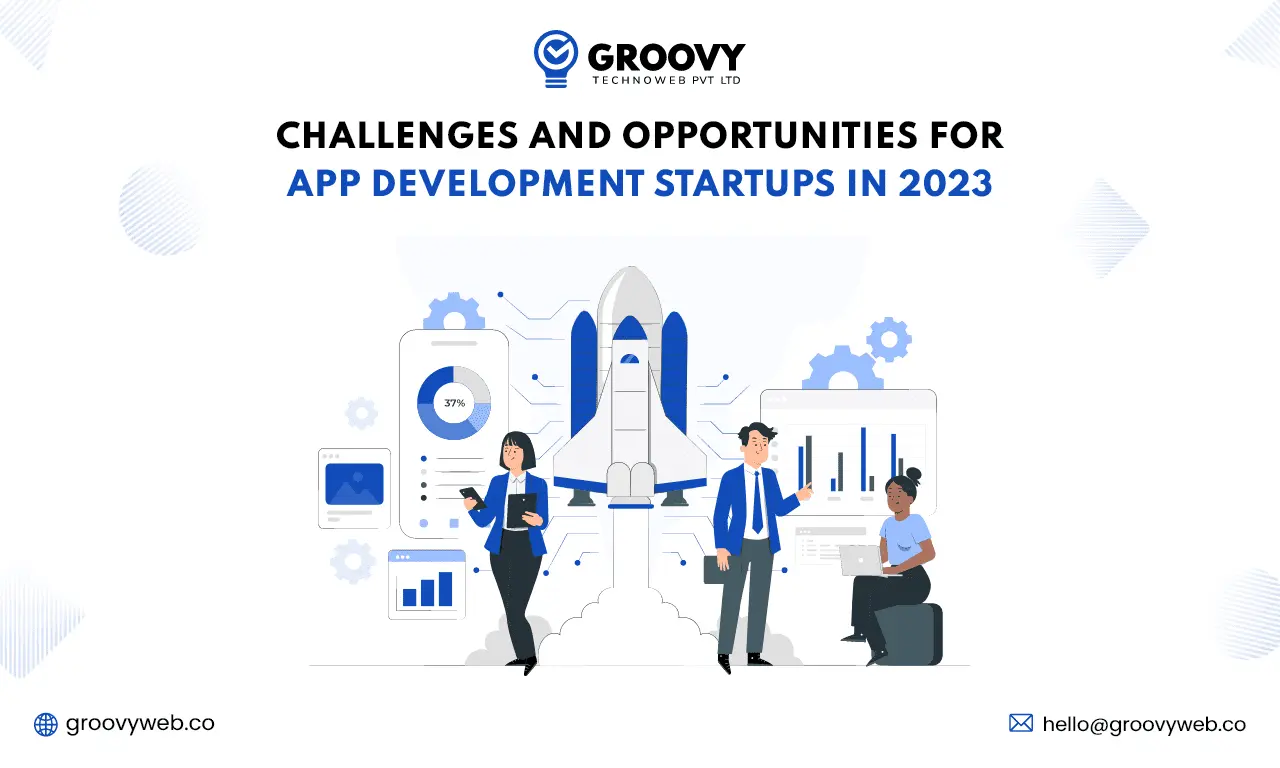
Quick Summary : App development startups face a competitive market with limited resources, tight budgets, and evolving technology. But by leveraging these challenges, you can establish a successful business. This article explores key challenges and opportunities for app development startups, offering insights to navigate them effectively.
Every business wants to grow on a digital platform, and the struggle to capture customer attention and improve user experience has made every sector highly competitive. To attract the attention of mobile users, you need a user-friendly application that can fix problems. Before you launch your mobile app, Please see this statistical data:
- Currently, there are more than 6 billion Smartphone users worldwide, and this number is expected to increase by hundreds of millions in the next few years.
- According to Statista, the Apple App Store has over 2.1 million apps, while the Google Play Store has over 3.5 million apps.
- Mobile application revenue is expected to reach $613 billion by 2025.
How to Create a Mobile App? : Discussing Amidst Challenges & Opportunities
Creating a mobile app startup involves turning a unique idea into a thriving business. To begin, identify a problem your app will solve and conduct market research to understand your target audience. Develop a comprehensive business plan outlining your app’s vision and revenue model.
Next, hire a skilled app development team or partner with a reliable company. Focus on creating an intuitive user interface and conduct thorough testing to ensure a smooth user experience. Implement a strategic marketing plan to attract users and continuously gather feedback to make improvements. Stay adaptable and scalable to grow your mobile app startup successfully.
Below are some basic challenges need to focus while start mobile app development company
1. Marketing and Promotion:
-
Marketing Strategy:
- Create a targeted marketing plan to reach the app’s intended audience, utilizing both online and offline channels.
- Tailor messaging and promotional efforts to showcase the app’s unique value proposition and benefits.
-
App Store Optimization (ASO):
- Optimize the app’s metadata and keywords to improve its visibility and ranking in app store search results.
- Use eye-catching visuals and compelling descriptions to entice users to download the app.
-
- Leverage popular social media platforms to build a community around the app and engage with potential users.
- Share engaging content, updates, and user testimonials to foster brand loyalty and increase app awareness.
-
Content Marketing:
- Develop valuable and informative content, such as blog posts and videos, that showcases the app’s features and benefits.
- Utilize content marketing to position the app as an authority in the industry and attract organic traffic.
-
Partnerships and Collaborations:
- Seek partnerships with complementary apps or influencers to expand the app’s reach to a broader audience.
- Collaborate on joint marketing efforts, co-branded content, or cross-promotions to drive user acquisition.
2. User Acquisition and Engagement:
-
User Acquisition:
- Implement a multi-channel user acquisition strategy, utilizing paid advertising, social media, and referral programs.
- Optimize ad targeting to reach the most relevant audience and encourage app downloads.
-
User Onboarding:
- Design a user-friendly onboarding process that guides new users through the app’s features and functionality.
- Provide in-app tutorials and prompts to help users get the most value from the app.
-
User Experience (UX):
- Prioritize an intuitive and seamless user experience, focusing on easy navigation and clear calls-to-action.
- Regularly gather user feedback to identify pain points and make continuous improvements.
-
Customer Support Strategies:
- Offer responsive customer support channels to address user inquiries and concerns promptly.
- Provide personalized assistance to enhance user satisfaction and retention.
-
User Feedback and Improvements:
- Encourage users to leave feedback and reviews within the app and app stores.
- Act on user feedback to implement updates and enhancements that align with user preferences.
3. Risks and Mitigation Strategies:
-
Identifying Potential Risks:
- Conduct a comprehensive risk analysis, considering technical, market, and financial risks that could impact the app’s success.
- Anticipate potential challenges in app development, launch, and user adoption.
-
Mitigation Strategies:
- Develop contingency plans to address identified risks effectively and minimize their impact on the app’s operations.
- Implement robust security measures to protect user data and ensure data privacy compliance.
-
Scalability and Growth:
- Plan for scalability from the early stages to accommodate growing user demands and increased traffic.
- Establish a roadmap for app updates and feature enhancements to sustain user engagement and growth.
9 Biggest Challenges that Every App Development Startups Focus in 2023
There are many challenges that you may encounter when developing mobile apps. It may be choosing how to develop the best apps or build apps that are good enough to succeed in a highly competitive marketplace.
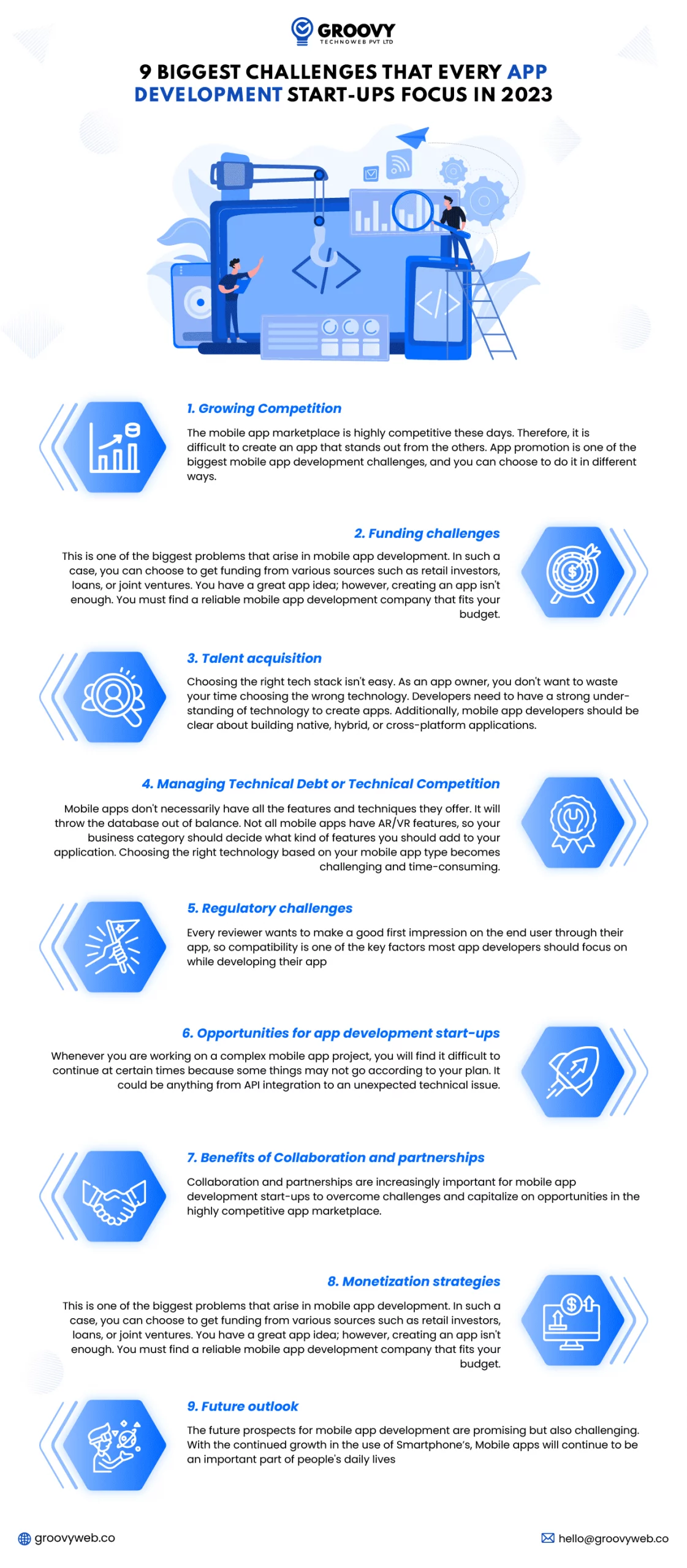
#1. Growing Competition
The mobile app marketplace is highly competitive these days. Therefore, it is difficult to create an app that stands out from the others. App promotion is one of the biggest mobile app development challenges, and you can choose to do it in different ways.
Getting noticed and discovered is one of those ways users can be easily discovered in the app market. They can just download it if your app works well and provides an amazing user experience, but it isn’t easily discoverable. You will not achieve your business goals. Make sure you review your app’s features to decide the best way to promote your app.
#2. Funding Challenges
You have a great app idea; however, creating an app isn’t enough. You must find a reliable mobile app development company that fits your budget and also you need to think about the cost of app development. Additionally, the cost will vary depending on your needs, App complexity, UX/UI design, and implementation of third-party APIs. App development can typically cost between $10,000 and $2, 50,000, so you need to consider all of these factors before you start developing the mobile app.
This is one of the biggest problems that arise in mobile app development. In such a case, you can choose to get funding from various sources such as retail investors, loans, or joint ventures.
#3. Talent Acquisition
When it comes to hiring app developers, there are some things that don’t work well if the right rules are not followed. Your developers should have the proper knowledge of technology. Choosing an inexperienced developer team can lead to greater challenges. A wrong decision can cost you a lot of money.
Choosing the right tech stack isn’t easy. As an app owner, you don’t want to waste your time choosing the wrong technology. Developers need to have a strong understanding of technology to create apps. Additionally, mobile app developers should be clear about building native, hybrid, or cross-platform applications. The right choice of technology gives mobile users access to adaptive and diverse apps. Therefore, selecting the right development technology is essential.
Using the latest mobile app technology, the customers want to develop apps using advanced features that help users manage their water delivery business seamlessly. After discussing all the requirements, we created a fully functional water delivery app solution for the customers.
#4. Managing Technical Debt or Technical Competition
Mobile apps don’t necessarily have all the features and techniques they offer. It will throw the database out of balance. Not all mobile apps have AR/VR features, so your business category should decide what kind of features you should add to your application. Choosing the right technology based on your mobile app type becomes challenging and time-consuming.
Today’s popular apps have a straightforward UI. The app’s first impression is based on user-friendly design principles and features, with an attractive and intuitive UI.
Sometimes software developers or businesses add many features to their app to make it an all-in-one app. But this annoys, confuses users, and reduces user engagement. According to 52% of users, poor mobile app experiences make them less interested in engaging with the organization.
Therefore, the poor UI design of the app directly causes a low user retention rate. High abandonment rate and low conversion rate, too, in designing an attractive UI for your app. Take some notes by reading about other apps similar to yours. This will help you offer your developers some ideas and information about how you want your app to appear.
#5. Regulatory Challenges
Every reviewer wants to make a good first impression on the end user through their app, so compatibility is one of the key factors most app developers should focus on while developing their app.
If the app doesn’t support popular devices or screen sizes, this can worsen the user experience. This is why testing mobile apps with different mobile devices and screen sizes are a breeze. It’s one of the toughest challenges for developers.
You should know that both Android and iOS have different mobile app development stages so you must study your target audience before starting the mobile development process. Also, ensure your app runs smoothly on Smartphone’s, tablets, and other mobile devices.
They are characterized by different screen resolutions, sizes, and pixel densities. App owners also face some challenges if they don’t employ a team of on-site developers. They can approach various app development service providers. It becomes a time-consuming process if you are comparing thousands of providers across the world.
#6. App Development Startups Opportunities
Whenever you are working on a complex mobile app project, you will find it difficult to continue at certain times because some things may not go according to your plan. It could be anything from API integration to an unexpected technical issue.
In this situation, it is better to contact the mobile development community and find relevant solutions that can help you fix all issues. You can discuss with the API support team to come up with a solution or formulate a new strategy to integrate advanced features and functionality into your app. You need to find out the root cause of the problem. After that, you can also brainstorm your app development team structure.
#7. Benefits of Collaboration and Partnerships
Collaboration and partnerships are increasingly important for mobile app development startups to overcome challenges and capitalize on opportunities in the highly competitive app marketplace.
- Access to Expertise: Collaborating or partnering with other companies can provide access to additional expertise and resources. For example, startups can partner with software development companies to access experienced developers, Project managers, designers, and other professionals.
- Shared Costs: Mobile app development can be costly, especially for startups with limited financial resources. By cooperating with other companies, Startups can share the cost of app development and marketing. It helps reduce the financial burden of each party.
- Reaching New Markets: Partnering with established companies with a presence in new markets can help startups reach those markets and increase their reach. For example, startups can partner with telecom companies to reach their customer base and market their app to them.
- Increased Visibility: Collaborating or partnering with established companies can help startups increase their visibility and open up to new audiences. This can lead to increased downloads, Greater User Engagement, and higher income.
- Faster time to market: Mobile app development can be a time-consuming process, especially for startups that still have to learn the ropes. Collaborating or partnering with experienced companies can help startups speed up the development process and bring their apps to market.
#8. Monetization Strategies
Monetization is an important part of mobile app development, and startups need to carefully consider monetization strategies in order to monetize and maintain their businesses. Here are some monetization strategies for mobile app development challenges:
- In-app advertising: This strategy involves displaying ads within apps. This allows app developers to generate revenue from ad impressions and clicks.
- In-App Purchases: This strategy involves offering additional features, content, or virtual goods within your app for a fee. This can help app developers make money from users who are willing to pay for premium features.
- Subscription Model: This strategy involves giving users access to premium content or features for a monthly or annual fee. This model can help app developers earn recurring revenue from loyal users.
- Freemium Model: This strategy involves offering a free version of your app with limited features and a paid version with additional features. This can help app developers make money from users who are willing to pay for premium features.
- Sponsorships: This strategy involves partnerships with brands or companies to promote their products or services within the app. This can help app developers monetize sponsorships and increase brand awareness.
- Affiliate Marketing: This strategy involves promoting third-party products or services within an app and earning a commission on each sale or referral.
#9. Future Outlook
The future prospects for mobile app development are promising but also challenging. With the continued growth in the use of Smartphone’s, Mobile apps will continue to be an important part of people’s daily lives. Here are some potential challenges and opportunities for future mobile app development:
- Increased competition: As the app market becomes more crowded, Startups are becoming increasingly challenging to stand out and gain market share.
- Emerging Technologies: Emerging technologies such as AR/VR, IoT, and AI will provide new opportunities for app developers to create innovative and personalized experiences for users.
- Security Concerns: With the increasing amount of personal data stored on mobile devices, App developers need to prioritize cybersecurity to ensure their apps stay safe and protect user data.
- Changing consumer behavior: When consumer behavior changes, App developers need to adapt and create apps that meet changing user needs and preferences.
- Increased globalization: With the increasing globalization of the app market, App developers need to consider localization and cultural sensitivity to cater to diverse audiences.
Latest Trends in Mobile App Development Startups
The latest trends in mobile app development are given by,
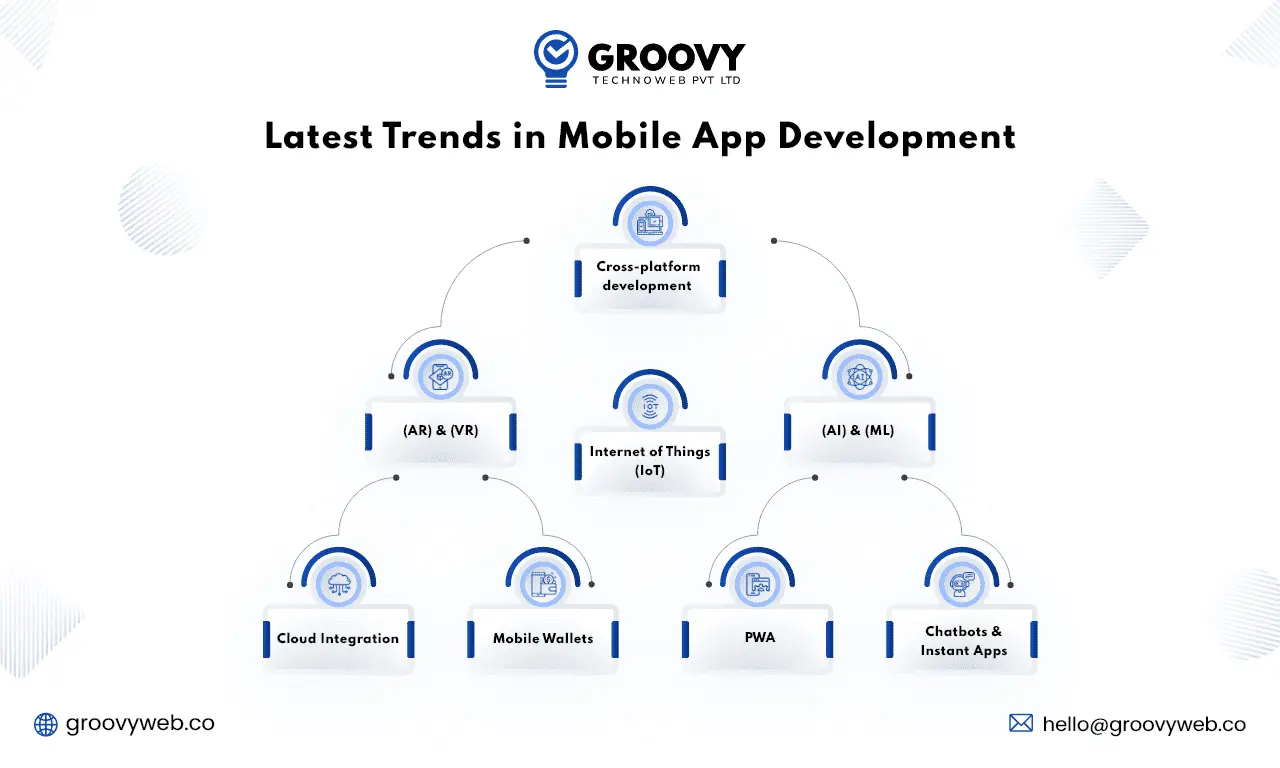
1. Cross-Platform Development
Cross-platform development means building mobile apps using a single codebase that can run on any iOS or Android platform. Coding your app once and publishing it to multiple platforms saves you time and money while reaching more customers with apps that have a consistent look and feel across devices. Some companies with cross-platform apps include Walmart, Instagram, and BMW.
Android and iOS solutions dominate the mobile app market (together with more than 99%) for many businesses. It’s more cost-effective to build cross-platform apps that are compatible with all platforms equally needed.
Cross-platform development is one of the mobile development trends that have not changed for many years. This approach helps businesses Reach a larger group of users, Reduce the time required to create a product, and optimize the cost of launching.
According to the guidelines, the Rejection of cross-platform development leads to about 23% of lost potential users if applications only run on Android and about 77% when building applications only for iOS.
Benefits of Cross-Platform Mobile Apps
- Users can run the app on any device and will have the same user interface and user experience.
- One support team is enough because the app will support different operating systems.
- Minimal upfront costs mean less risk for investors and developers.
- wider audience
- easy maintenance of the program
2. Internet of Things (IoT)
IoT is far from a new idea, but the increase in penetration of mobile devices across various sectors and types has created seemingly endless opportunities for the Internet of Things.
IoT describes a growing network of internet-connected devices that provides convenience and automatic control to consumers. Smart home technology is a perfect example of the rise of IoT and mobile app development.
A mobile app can be used to adjust the temperature in your home remotely, Lock or unlock the front door and connect to the home security system; Fridges and other household appliances can be connected to the mobile app as well.
The global Internet of Things market is expected to reach $318 billion by 2023, with $226 billion of that estimate coming from software such as mobile apps.
3. Artificial Intelligence (AI) and Machine Learning (ML)
It’s no surprise that AI and ML are on this list. They are likely to be among the top mobile application development trends in 2019, and they are on the list for 2021.
AI and ML are the powers behind chatbots, face detection, motion detection, recommendation tool speech, recognition, text prediction, financial forecasting, and much more as technology advances. The number of ways and ease of integration with mobile apps has also increased.
IT, marketing, finance, and customer service are leading industries where AI and ML have been integrated into apps to notorious success. Google, for example, succeeded in creating Duplex, which can make calls on behalf of humans to resolve appointments. AI and ML will become increasingly important in the application development space.
4. Augmented Reality (AR) and Virtual Reality (VR)
Augmented reality will continue to grow in 2023. Mobile apps can use AR features for a variety of use cases. But nowadays, Apps for AR have become more practical for other apps as well. The app uses AR technology to show different hairstyles and hair colors directly to the user. L’Oreal has created a virtual makeup app using AR to see how the makeup looks on the user’s face.
Even Google Maps is rolling out a feature called “Live View,” where users can see real-time turn-by-turn directions on a live image. When pointing your device’s camera at buildings and road signs, the app will be able to know exactly where the user is.
While these examples may not necessarily be helpful for most apps developed in 2023, there are other ways. There are more ways to use AR in mobile apps. Adapting AR is a popular app development trend for content creators. This technology helps you to get creative as Instagram and Snapchat do with face filters.
Virtual reality has also shaken things up in the world of mobile application development especially for game apps, VR technology can connect with phones, apps, and wearable’s to enhance the gaming experience of fully functional mobile apps. Today, the mobile world makes use of augmented reality and virtual reality for more practical purposes, such as:
- object measurement
- navigation
- interior design
- study
- user manual
5. Cloud Integration
Although cloud technology is not new, it has not yet penetrated the mobile app industry to its full potential but this is a mobile app development trend that you definitely need to keep an eye on. Cloud computing offers many possibilities for mobile development, which will be implemented in 2023.
The cloud storage technology can improve the performance of mobile apps at the user’s end. Apps can store data and perform complex tasks on the cloud instead of storing the data directly on the user’s device; this not only streamlines the development process.
By 2023, 83% of enterprise workloads will be cloud-based. If your agency is building apps for businesses or apps for internal employees, you must keep an eye on cloud computing trends in 2023.
6. Mobile Wallet
Mobile wallets such as Apple Pay, Google Pay, and Samsung Pay are rising. According to the latest report, there were $6.1 billion in transactions from mobile wallets in 2019, expected to reach $13.98 billion by 2023.
In the next two years the mobile wallet market should double. Slowly but surely, Smartphone users are accepting mobile payments. They are also taking advantage of app functionality for making payments on connected wearables. In the next few years, all mobile apps need to consider mobile payments.
Mobile wallets must be taken into account in app development in 2023. Wallet integration should become a standard feature for all transaction processing apps. Currently, this is not the case, but in-app mobile wallet penetration rates will increase dramatically in the next few years.
After 2020, the number of mobile payment app users has grown exponentially. This is largely due to the COVID-19 pandemic and the public’s avoidance of cash payments. As a result, more than two billion people will use mobile payments in 2021.
In addition to a large number of banking applications, the most widely used payment apps are Apple Pay, Google Pay, PayPal, AliPay, WeChatPay, and Zelle. These apps allow users to make financial transactions faster, easier, and from anywhere. As a result, mobile commerce is booming. In 2023, the trend of developing e-commerce apps for mobile payments will continue.
7. Progressive Web App Development
Progressive web apps (PWAs) are popular because they help fill in the void left by most traditional apps and web pages. It will benefit from reduced reliance on Internet connections, faster loading times, automatic updates, and faster time-to-market, making PWAs a popular choice for customers and companies. Well-known PWA sites include Pinterest, Forbes, and Trivago.
Progressive Web Apps (PWAs) are a relatively new development in mobile app development. It is a web application that functions like a normal mobile app. But built using web technologies such as HTML, CSS, and JavaScript, it can be installed on the user’s device and accessed through an icon on the home screen. The same applies to native apps.
Recent trends in PWA development include:
- Increased use of push notifications: Push notifications are an effective way to engage users and keep them coming back to your app. With PWA technology, developers can now send push notifications to users who have apps installed on their devices.
- Improved offline functionality: PWAs are designed to work even when there is no internet connection. This means developers focus on creating a better offline experience for users, such as storing local data and enabling users to continue using the app even when not connected to the internet.
- Increased adoption of machine learning: Machine learning is increasingly important in mobile app development, and PWAs are no exception. Developers are using machine learning algorithms to provide users with personalized content and recommendations and improve user experience.
- Focus on performance: PWAs are generally faster than native apps because they don’t need to be downloaded and installed. However, developers are still working to improve performance by optimizing their code, reducing file size, and using other techniques. This ensures that the app loads quickly and smoothly.
- Integration with other technologies: PWA can be integrated with other technologies, such as virtual and augmented reality, to give users a more realistic experience. Developers are exploring new ways to combine PWA with these technologies to create engaging and creative mobile apps either android application or PWA iOS.
8. ChatBots and Instant Apps
Chatbots have been around for over a decade. Over the years, Chatbots have evolved and become more advanced. Chatbots on the web have grown in popularity due to consumer demand becoming the new standard of customer service.
But out of the millions of apps available on the Apple App Store and Google Play Store, only a small percentage use chatbots. That will change in 2023. Since the chatbot is powered by AI technology, the responses are more human-like. The global chatbot market is growing by 24% each year. It is estimated that 25% of all customer service technology interactions will be facilitated by virtual assistants by 2020 to make this happen.
Android Instant Apps were released a few years ago, but we will see more usage and development in 2023. Android Studio helps developers create instant app experiences to improve the discovery of their apps. You can also try the app without installing it, just click on the “Try Now” button.
Instant Apps are gaining popularity as they allow users to test apps before downloading and installing them. Companies that use PWAs and Instant Apps can benefit from improved performance, better customer experience, and lower development costs. Instant Apps have a size limit. So it doesn’t always have to be the full version of the app, but these limitations may change over the next few years.
App users want a better experience, and allowing them to use apps without downloading them is a great way to give them that. For mobile commerce app Hollar is the best example, was able to increase conversions by 20% by launching an instant app. 30% of all Android traffic came from Instant App. If you are developing apps for the Google Play Store in 2023, you will also need the Instant version.
Conclusion
Mobile app development is ever-changing. If you are building an app today using data from two or three years ago, you won’t be able to compete. With the help of mobile app industry trends can make or break the success of your project.
As a retailer or mobile app development company, you can follow the 2023 mobile app trends just like your bible. This is how you can gain an edge in your area. All mobile app developers in your team need to understand mobile app development trends and integrate them into the app development process. You don’t need every trend in every app you build, But you need to have a general understanding of how the market changes so that you can adjust accordingly.
Written by: Ashok Sachdev
Ashok Sachdev is the Project Manager at Groovy Web who began his professional career as a programmer at the young age of 17. Ever since then he is actively growing, learning new things, and adapting to new roles and responsibilities at every step. Aside from being an app developer, he is highly admired for his project management skills by his clients.
Frequently Asked Questions
We hope these clear your doubts, but if you still have any questions, then feel free to write us on hello@groovyweb.coHow important is it for app development startups to stay current with emerging technologies?
To be competitive and relevant in the market, app development firms must stay current with evolving technology. It helps them to create creative and cutting-edge goods that respond to changing consumer demands and expectations.
What are the key features every successful app should have?
Every successful app should have an easy-to-use interface, a quick load time, efficient performance, and the ability to work offline. Additionally, successful apps should include features that cater to their target audience's needs, such as personalized recommendations and push notifications. User trust and retention are also influenced by security and privacy features.
In-app purchases and monetization options are critical for the app's long-term development and growth. To maintain user engagement and satisfaction, regular updates and bug fixes are required. Finally, in order to meet the needs of a diverse user base, successful apps should provide a seamless and integrated experience across multiple platforms, such as desktop and mobile devices.
How to measure the success of your app and improve user engagement?
To improve user engagement, you can implement features such as push notifications, personalized content, social media integration, and in-app rewards. It is also important to regularly analyze user feedback and make necessary updates to address any issues or concerns they may have. By continuously evaluating and improving your app's performance, you can increase user satisfaction and drive greater success for your app.
Related Blog

Rahul Motwani
How Much Does It Cost to Develop a Custom Application
Software Development 29 Dec 2022 9 min read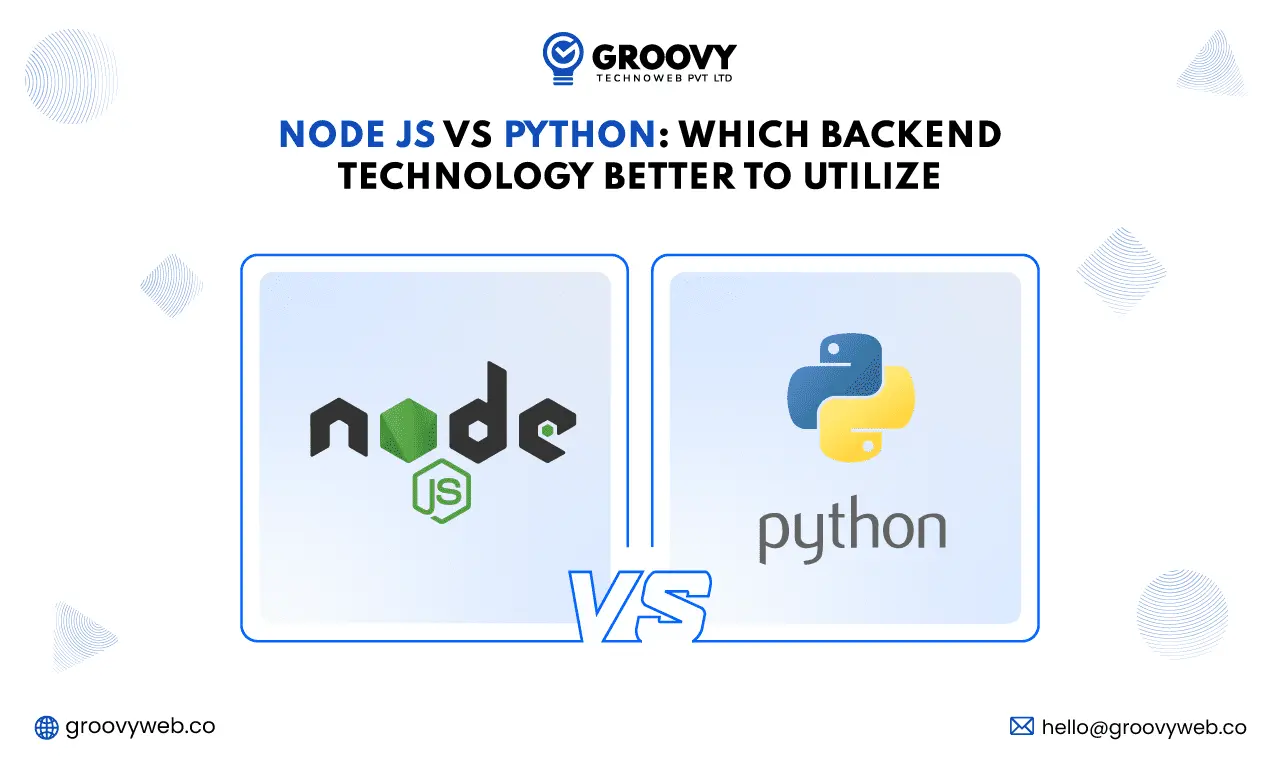
Rahul Motwani
Node JS vs Python: Which Backend Technology Better To Utilize
Web App Development 12 Jun 2023 8 min read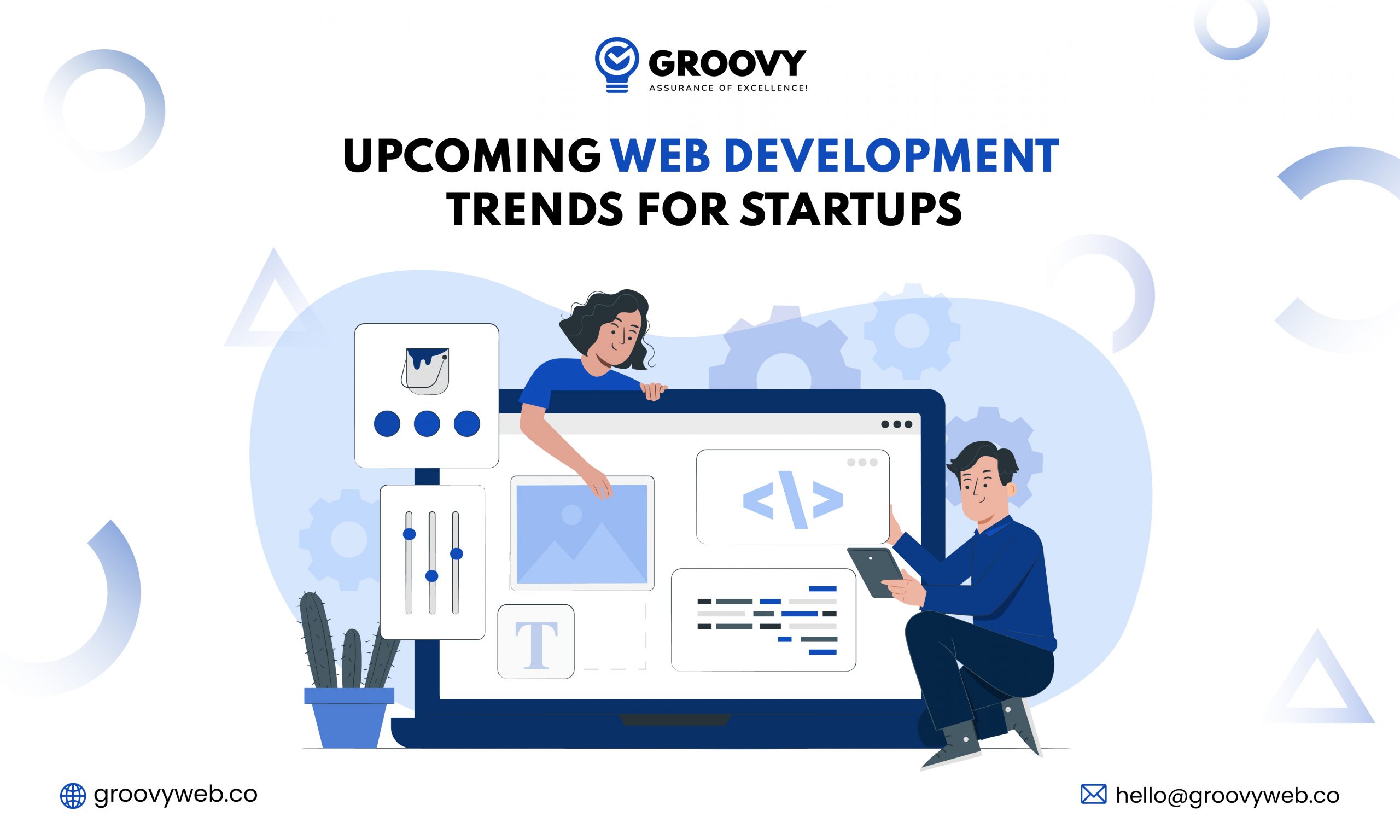
Sagar Patel
Top 22 Upcoming Web Development Trends For Startups in 2023
Web App Development 06 Feb 2023 18 min readSign up for the free Newsletter
For exclusive strategies not found on the blog